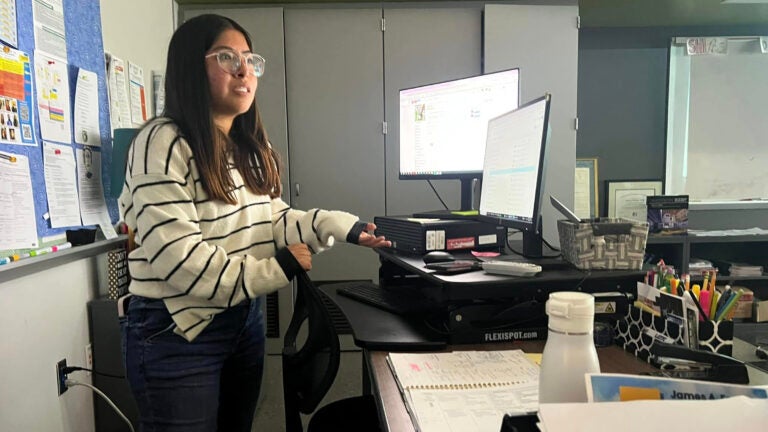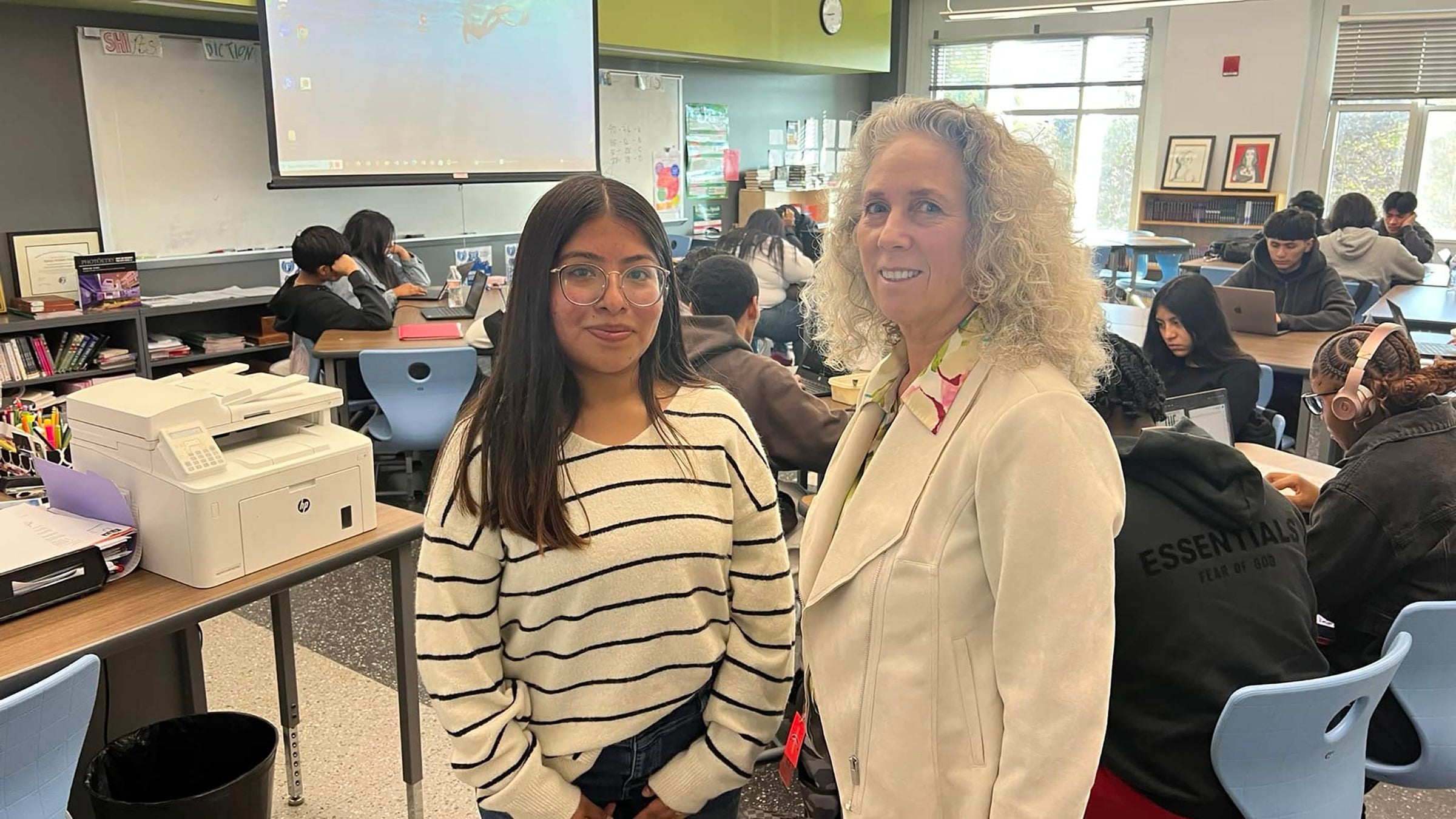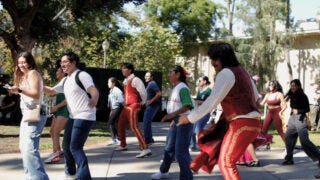
When Wendy Chavez was a student at the James A. Foshay Learning Center, she had her eyes fixed on attending USC. The USC Leslie and William McMorrow Neighborhood Academic Initiative helped her get there. (USC Photo/Greg Hernandez)
Trojan heads back to her high school to pass on lessons
USC Annenberg’s Critical Media Project provides Wendy Chavez with the opportunity for a rich, “full-circle” experience at L.A.’s Foshay Learning Center, her alma mater.
Standing in front of a classroom of 25 students at the James A. Foshay Learning Center in early December, junior Wendy Chavez of the USC Annenberg School for Communication and Journalism broke some news to the group: “We’re coming to the end of my lectures.”
There was a chorus of disappointed moans, with one student dramatically yelling above the din: “Noooo!”
The reactions signaled to Chavez that she had connected with the high school juniors she’d been teaching for the previous six weeks.
A 2022 graduate of Foshay, Chavez returned to her alma mater as part of Communications 367, USC Annenberg’s “Community Engagement and Service Learning” course that calls for undergraduate students to work with local high schools and teach media literacy material from the school’s Critical Media Project. The project aims to help prepare the youths to challenge stereotypes, bias and discrimination they may encounter in media and to enhance their critical thinking skills and empathy.
Chavez received the same media literacy lessons when she was a high school junior at Foshay, taught by a USC student over Zoom during the COVID-19 epidemic. The material had a lasting impression.
“I learned so many different terms like ‘intersectionality’ and ‘social construct,’ and it sparked my interest,” Chavez said. “My main goal for doing this class was to spark an interest in them and a new understanding of what affects us not only in school, but outside of school.”
The lessons Chavez taught this fall were also designed to provide students with the tools to reimagine their futures in college and the workplace with a more powerful voice. The curriculum for middle and high school students combines critical media consumption with media making, the creation of media. It explores questions of identity in the areas of race and ethnicity, class, gender, sexuality, religion, disability and age.
The road back to Foshay
USC Annenberg Clinical Professor of Communication Alison Trope, founder and director of Critical Media Project, was excited that Chavez wanted to be one of the students who implements the curriculum, and set in motion Chavez’s return to Foshay. The school is about a mile west of the USC University Park Campus.
“I don’t remember anyone else being able to have this kind of full-circle moment,” Trope said. “I thought it would be so amazing if we could pair her with her own school.”
Trope reached out to Chavez’s high school English teacher, Kate McFadden, who has worked at Foshay for 35 years and had previously hosted USC Annenberg students in the program. McFadden offered Chavez the opportunity to teach the curriculum as part of her Career Exploration class, an elective she teaches in addition to senior English and English language development classes.

“It’s always nice to see our Foshay students giving back and staying part of the community,” McFadden said. “Wendy was a good student. But seeing her two years later, coming in with such authority, it’s been really nice. You can see the growth that happens in college: the confidence, the depth of thought, the exposure to different thinking.”
Challenging career stereotypes
Because she was teaching in a career-oriented course, Chavez brought that particular focus into every lesson she taught. During her sessions with the class of predominantly Latino students, she shared media content featuring various careers and discussed how areas of identity such as race and gender intersect and how those intersections might present career challenges. She also covered how the students can advocate for their own needs in a particular career field.
“The career focus was unique, and Wendy took that and ran with it,” Trope said. “It was important for the students to think about the possibility that they may face inequity when they go out into the work world.”
For their final project, students were tasked with creating movie posters that challenge career stereotypes. One student’s movie, for example, was titled “The Doctor’s Calling” and had the tagline: “No matter what your race, gender and color, you can do what you want to do.” Another was titled “Shaping New Horizons” and was about a Black woman becoming an OB-GYN.
“My poster isn’t just for Black women but for all women who might feel like they can’t be successful,” the student said during her presentation.
Several students complained to Chavez that they had struggled to find online media content of people of their ethnicity in advanced professional roles. One student could only find images of white doctors, while another struggled to find an image of a Latino firefighter for his film titled “Flames of My People.”
After students presented their movie posters, Chavez shared this piece of advice: “Make connections with other people who you know who have the same struggles. If you ever feel impostor syndrome, just know that it’s super normal, and you will get through it by advocating for what you want.”
A neighborhood connection
A few days after teaching her last class, Chavez said it felt “very nostalgic” being back at her old high school. But from the beginning of her time teaching this course, her sense of empowerment overcame the awkwardness.
“It felt a little weird initially because there’s not that much of an age gap between me and the students, and I wondered if they were going to pay attention to me,” Chavez said. “My first day, I went to go visit my math teacher and he was like, ‘What are you doing here?’ I was able to say, ‘I came to teach.’”
When Chavez was a student at Foshay, she had her eyes fixed on attending USC. She increased her chances by taking part in the USC Leslie and William McMorrow Neighborhood Academic Initiative access program. NAI provides specialized training toward success in higher education and beyond for students living in the neighborhoods near USC’s University Park and Health Sciences campuses. More than 1,500 seniors from Foshay, Woodrow Wilson and Abraham Lincoln high schools have completed the NAI program and attended college since it began in 1997.
“We would have summer classes at USC for SAT prep, English and math,” Chavez said. “I made my lifelong best friends through NAI and now we’re together at USC, which is amazing.”
Starting in the sixth grade, NAI offers academic support and resources to prepare students — including many who will be the first in their family to attend a four-year university — for admission, the academic rigors of college and graduation. The program has a 100% high school graduation rate and a 99% college graduation rate.
Trope finds it especially satisfying when NAI alums are able to share Critical Media Project lessons with students at NAI schools and other schools around USC.
“We have this pipeline through Neighborhood Academic Initiative,” Trope said. “I hope that this can happen more.”



